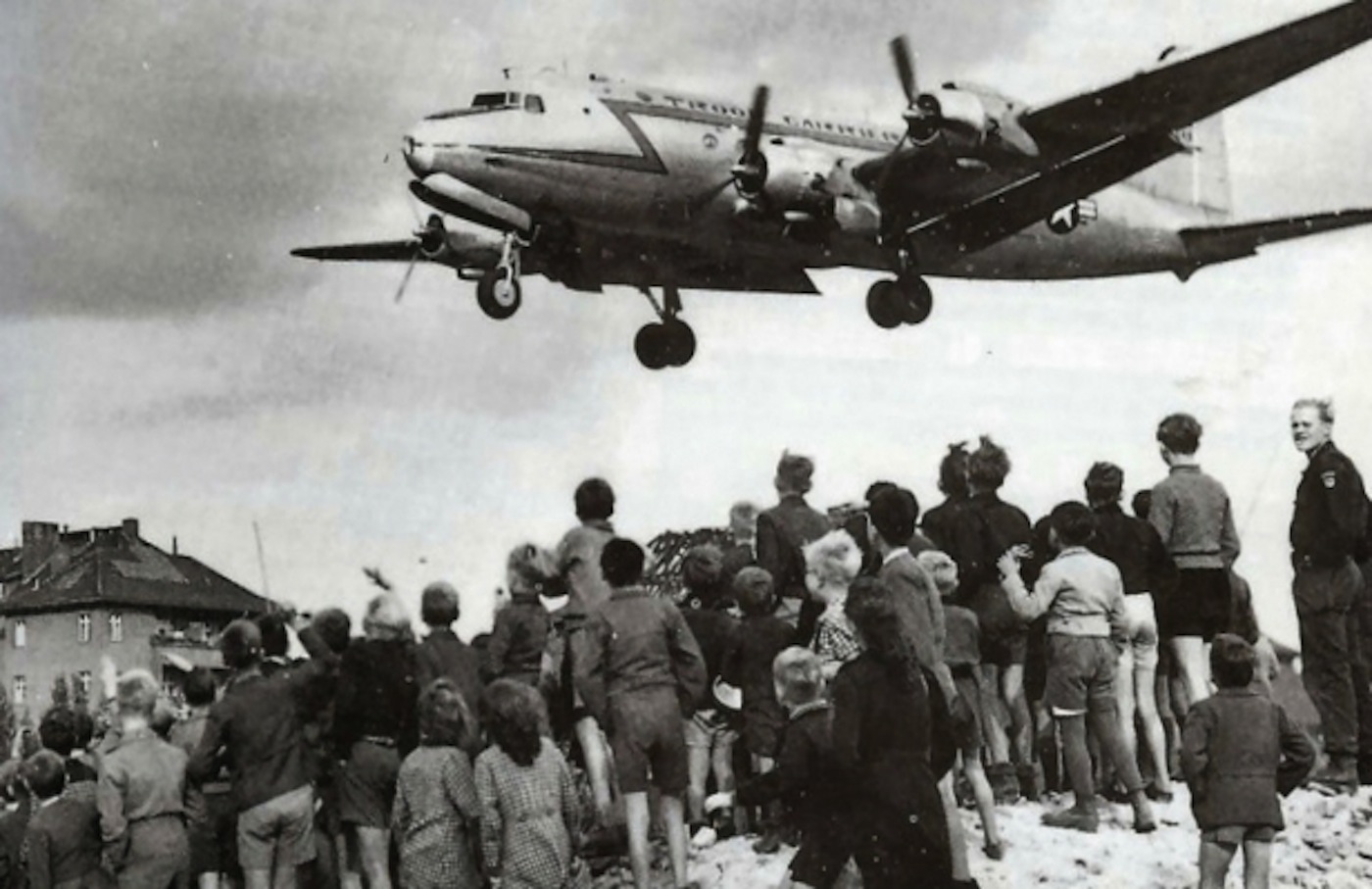
The Berlin Airlift
In the story of people, there are many tales of those who've done good things. Some such stories include persons giving a helping hand to a neighbor, while others give generous amounts to charity.
But few such stories are in the same class as the story of a group of people who went to extreme lengths to save the lives of those who were their enemies only a few years earlier.
Let's learn the unforgettable story about the Berlin Airlift.

The end of the world
The year 1945 brought the end of the second world war. For most, this was a time of major celebrations.

But war's end saw a Germany in total ruins, in part by the bombing
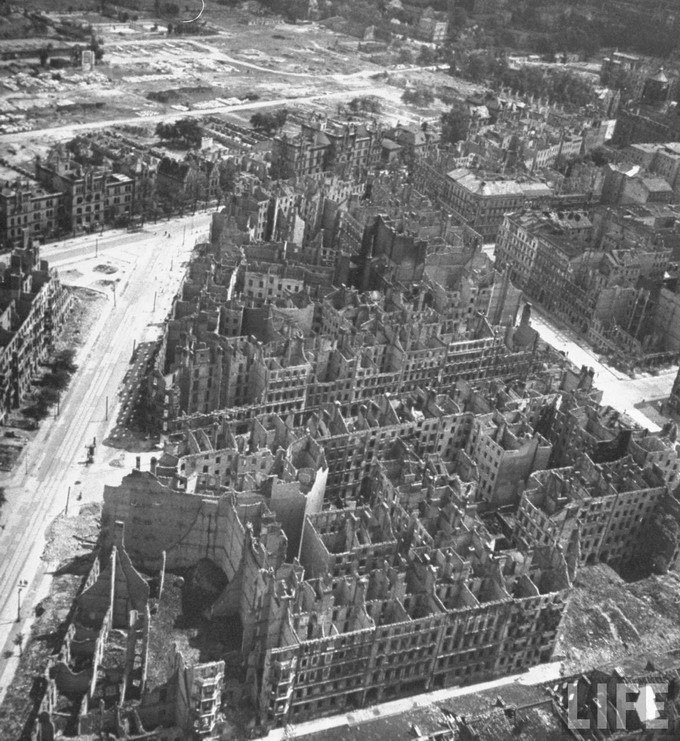
and part due to the fighting on the ground – especially in Berlin.
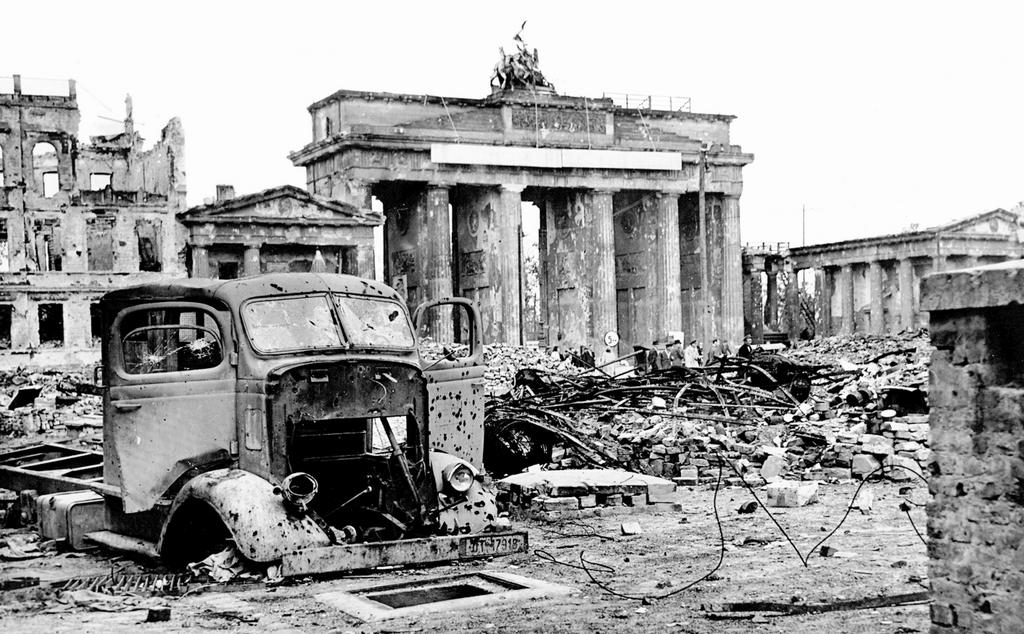
Life was a living nightmare for those left to pick up the pieces of a shattered Germany.
Adding to the craziness, Germany was divided up between the victorious powers – the United States, the Soviet Union (Russia), Great Britain and France.

Division of Germany map by “Дмитрий-5-Аверин.”* Russia occupied the top right, Great Britian up top, the United States at the bottom, and France in between.
But it gets crazier still.
Not only was the whole of Germany divided up, but the capital city of Berlin itself was divided, the eastern half fell under Soviet control and the western half was divided between the rest.
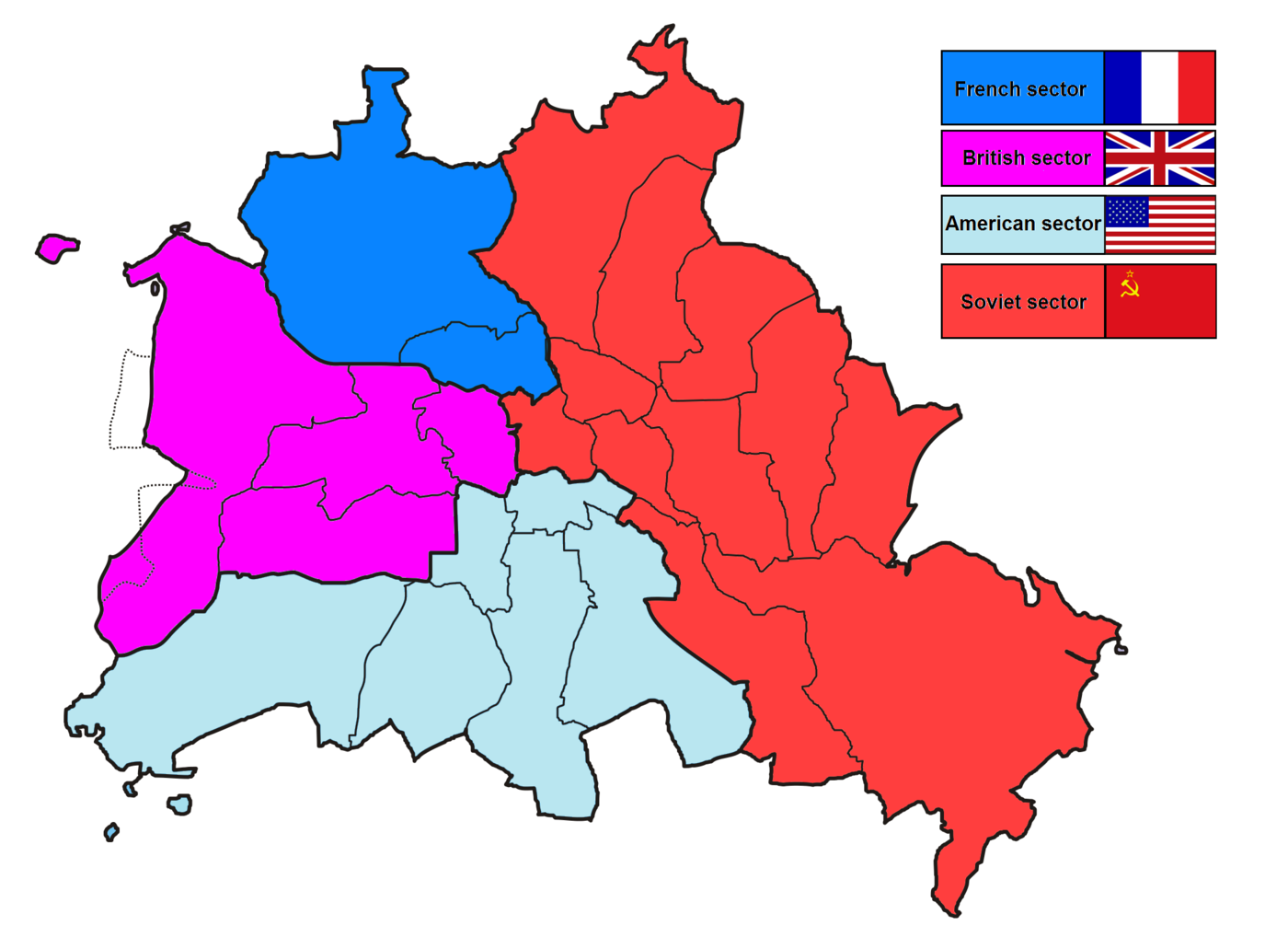
Map of a divided Berlin into its sectors. Created by Paasikivi**.
And still, there were more troubles for the German people.
Thrown together by war, the big powers wasted no time showing a lack of unity after the war came to an end.
Although allied with the others, the Soviets almost behaved as if they were separate from the rest.
There were concerns about the Soviets using the war outcome to take over eastern Europe. Whenever Joseph Stalin, the leader of the Soviet Union, was asked about this he would simply say “We'll talk about it later.” Now these suspicions were being confirmed.
France had not been included in the talks about the division of Germany, and so felt no real obligation to follow all the rules.
Cooperation between the countries started breaking down. Each “zone” had its own laws and even currency.
It was a mess.
The Cold War was beginning.
Things boil over
The situation exploded in 1948 – three years after the war. To promote the German general welfare and limit Russian power, the three powers (minus Russia, of course) created a new version of the Deutschmark; the German money.
Infuriated, the Soviets decided to take action.
They decided to take over all of Berlin. It is June 24, 1948.
The approach was to cut anything going into, or out of, West Berlin. It was a siege intended to starve the population into surrendering. Of course, the difficult part is that west Berlin had soldiers from their "allies" stationed there. But that shouldn't be a problem; surely they don't want another World War over tiny Berlin. Surely they'll just scamper away and go home without a fight.
Surely.
But they didn't. They stayed.
To the rescue
There may be many reasons the allied governments decided not to leave. Of course there's the human element – how could they abandon anyone to starvation, only to then be turned over to the socialists?
Then there's politics. The Soviets were now the enemy and, I dare say, there was some "you can't just kick us out" attitude. But regardless of the reasoning, it was decided this was one siege that needed breaking.
But how?
There was only one possible way. By agreement, there were three “air corridors” – paths planes can fly along, that could be used to send in supplies by air.
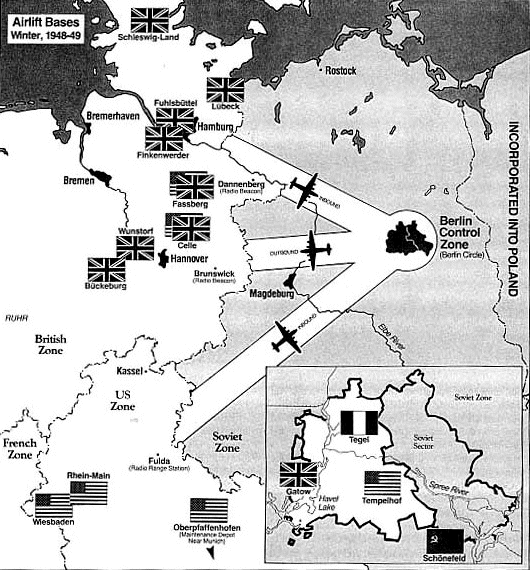
The task was to supply the needs of a city of over 2 million people (about the size of Chicago) with a decent supply of food, fuel and other supplies during the cold German winter.
Their resources? To start, only a few Douglas C-47 Skytrains available as cargo planes.

Still, the British and Americans set to work to make this happen, all the while being mocked by the Russians claiming this was an impossible stunt. But things started coming together.
Officially, it was called Operation Vittles. Unofficially, it is called the Berlin Airlift.
There were a couple of factors that helped make the miracle happen:
Hundreds of planes were brought in for the airlift. Pilots who, only a few years earlier, had worked hard to reduce this same city to rubble now came to save it.
The German people worked hard to help load and unload the planes. Pretty German young ladies (they being so described) helped serve hot food and drink to the pilots so they didn't need to leave their aircraft. Former mechanics for the Luftwaffe (German air force) helped service the planes. One-time enemies now working together.
The man put in charge was Major General William H. Tunner. In the war he had earned the reputation of being "the transportation expert to end all transportation experts." He did not disappoint. He hated waste and was able to get flights to Berlin, leaving every 90 seconds – 24 hours a day, 7 days a week for months.
Imagine what that must have looked like. In the air, long ribbons of airplanes flying along their paths, bringing in supplies. On the ground, countless people, like ants, worked on loading and unloading the precious cargo, and repairing damaged airports.

Line of airplanes at Berlin's Tempelhof Airport, being unloaded.
Former enemies doing all this together.
Life on the streets
The miracle was coming to pass, but it took time to gear up and start bringing in the 1500 tones of supplies each day required by the airlift.
Meanwhile, Berliners needed to make it through somehow, including getting through the fiercely cold winter. Adding to their problems, the power plants were in the Russian zone, and they would, from time to time, cut off the electricity to West Berlin. Adding to this was the fear that the Soviets would end up taking over in the end.
To say Berlin had fallen into hard times is an understatement.
Little vittles
As if the whole story of the airlift wasn't impressive enough, there is a story in it that is impressive in its own right. The story of Gail S. Halvorsen, the “candy bomber."

One day, with some time on his hands, he ends up talking with some Berlin children standing just outside the fence around the airport. Speaking with them two things happen. First, he lost track of time talking to them.
Second, he is very impressed with them. For these children, hunger and starvation were daily facts of their life, and yet, they seemed more concerned about losing their newly gained freedom (the first they've known in their life) to the Soviets. Lieutenant Halvorsen is very moved by this.
On impulse, he offers what little he had on hand, some gum. Imagine his response when the children divided up the gum between them. Even smelling the wrapper was a special treat.
He realized he needed to do more.
He arranges to drop candy to the kids on his next flight. Recruiting his flight crew, the candy got attached to handkerchief parachutes, and the drop is made.
Halvorsen kept dropping candy, and his popularity grew. This became known as Operation Little Vittles.

As word got out, and people all over the United States and England send candy and handkerchiefs to keep up the good work. When Gail's superior officer heard about this, he was called into his office for a chewing out – not that he disapproved, he just wanted to be told.
This operation within an operation helped support the larger goal in its way. It helped give hope to people who were needing hope desperately.
The sun comes out
The gloom notwithstanding, the sun did come out. The people of Berlin made it through the winter and began looking forward to pleasant weather. Also, the airlift really started things going. The final blow for the Russian plan came in April of 1949 when a record 128,491 tones were delivered in a single day.

That did it. Russia realized the dance was over and it was time to give in. The blockade was lifted. The city was saved!
So what came from all this? Clearly, it is a beautiful story of compassion on a large scale. Politically, Germany would be a divided nation for the next 40 years.

Map by “Дмитрий-5-Аверин."*. The eastern half was known as East Germany and is depicted by the East German flag. Likewise, the western half was known as West Germany and is represented by its flag.
A wall built between the two countries kept people from leaving East Germany.
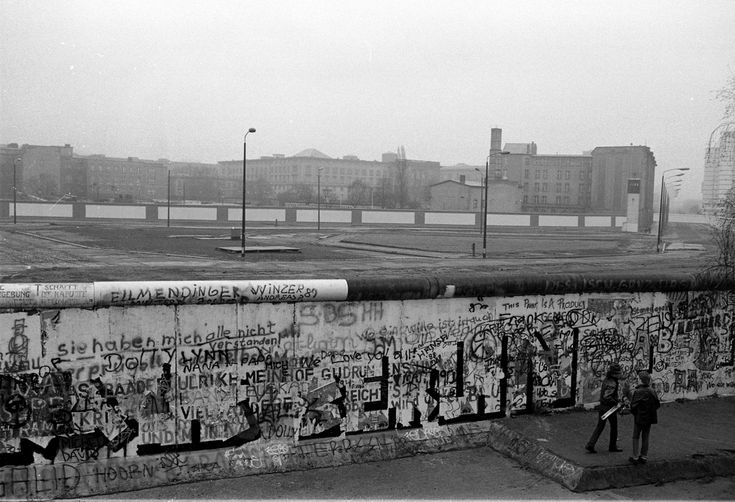
But on a good note, lessons had been learned about how to handle large numbers of flights, lessons applied in busy airports of today.
Indeed, goodness is its own reward, but it is sure nice to have extra benefits. That's what history is all about.

Memorial to Berlin Airlift, courtesy Stars and Stripes.
Great movies
Walls
This is an inspiring short film put out by Candlelight media. It begins in 1949 soviet occupied East Berlin near the end of the blockade and while the wall between the two Germanys was going up. A family escapes, but one does not make it due to a betrayal of a good friend of the main character. For decades afterward, he could never forgive his old friend.
Forty years later, the hated wall is coming down, and his wife and daughter go to be part of this exciting event when, to his surprise, he sees his friend as a guard on the other side. Now he must deal with the ghosts of his past and find forgiveness.
This video is usually part of a video called Beyond Barriers.
On the web
Berlin Airlift The Story Of A Great Achievement 1949
This is an old film that goes over the airlift.
The Soviet blockade of West Berlin (1948–1949) and the allied airlift
This video presents more of a presentation of the airlift, including the reasons behind it.
The Candy Bomber An Advent Story of Hope
The story of the Candy Bomber.
*Shared through creative commons license 3.0.
**Shared through creative commons license 4.0.
Don't miss out on future posts! Sign up for our email list and like us on Facebook!
Check out more hot topics, go back to Home Page
Comments? You can contact me at mailbox@thehomegrownprofessor.com